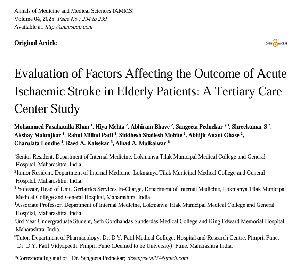Evaluation of Factors Affecting the Outcome of Acute Ischaemic Stroke in Elderly Patients: A Tertiary Care Center Study
Authors
##plugins.themes.bootstrap3.article.main##
Abstract
Introduction: Stroke is a major cause of mortality and disability, with elderly patients at higher risk. Ischemic stroke, the most common type, results from embolic or thrombotic arterial occlusion. Prognostic assessment is essential for guiding management and rehabilitation. This study evaluates prognostic factors in elderly acute ischemic stroke patients, particularly the National Institutes of Health Stroke Scale (NIHSS) and Orpington Prognostic Scale (OPS). Materials and Methods: This prospective observational study included 50 patients aged ≥60 years diagnosed with acute ischemic stroke. Clinical history, neurological exams, NIHSS scoring, and radiological investigations were conducted. Follow-up at six months assessed functional recovery using OPS. Statistical analysis was performed using SPSS v20.0. Results: The mean age was 71 years, with a male predominance (66%). Hypertension (66%) and diabetes (48%) were key risk factors. Fever (>38°C) correlated with poor outcomes (55% mortality/worsening). NIHSS >21 and GCS <8 predicted worse prognosis. At follow-up, 60% improved, while 14% worsened or died. Conclusion: Strict blood pressure and glucose control, early rehabilitation, and stroke unit care improve prognosis. NIHSS and OPS are valuable for assessing stroke severity and outcomes.
##plugins.themes.bootstrap3.article.details##
Copyright (c) 2025 Mohammed Fasahatulla Khan, Hiya Mehta, Abhiram Bhave, Sangeeta Pednekar, Shreekumar S, Akshay Malunjkar, Rahul Milind Patil, Siddhesh Shailesh Mohite, Abhijit Anant Ghase, Charulata Londhe, Raed A. Kalsekar, Alhad A. Mulkalwar

This work is licensed under a Creative Commons Attribution 4.0 International License.
Creative Commons License All articles published in Annals of Medicine and Medical Sciences are licensed under a Creative Commons Attribution 4.0 International License.
[1] Ingall T. Stroke-incidence, mortality, morbidity and risk. J Insur Med. 2004;36(2):143-52.
[2] Truelsen, Thomas & Begg, Stephen. (2006). The Global Burden of Cerebrovascular Disease. World Health Organization.
[3] Adams HP Jr, Bendixen BH, Kappelle LJ, Biller J, Love BB, Gordon DL, Marsh EE 3rd. Classification of subtype of acute ischemic stroke. Definitions for use in a multicenter clinical trial. TOAST. Trial of Org 10172 in Acute Stroke Treatment. Stroke. 1993 Jan;24(1):35-41. doi: 10.1161/01.str.24.1.35.
[4] Banerjee, T.K. & Das, Shyamal. (2006). Epidemiology of stroke in India. Neurology Asia. 11. 1-4.
[5] Antihypertensive drugs in stepped doses reduced stroke in elderly patients with isolated systolic hypertension. ACP Journal Club Archives. 1991;115(3):65.
[6] Shekelle RB, Ostfeld AM, Klawans HL Jr. Hypertension and risk of stroke in an elderly population. Stroke. 1974 Jan-Feb;5(1):71-5. doi: 10.1161/01.str.5.1.71.
[7] Tuttolomondo, Antonino & Maida, Carlo & Maugeri, Rosario & Iacopino, Domenico & Pinto, Antonio. (2015). Diabetes & Metabolism Relationship between Diabetes and Ischemic Stroke: Analysis of Diabetes- Related Risk Factors for Stroke and of Specific Patterns of Stroke Associated with Diabetes Mellitus. Journal of Diabetes & Metabolism. 10.4172/2155-6156.1000544.
[8] Hedna VS, Bodhit AN, Ansari S, Falchook AD, Stead L, Heilman KM, Waters MF. Hemispheric differences in ischemic stroke: is left-hemisphere stroke more common? J Clin Neurol. 2013 Apr;9(2):97-102. doi: 10.3988/jcn.2013.9.2.97.
[9] Georgilis K, Plomaritoglou A, Dafni U, Bassiakos Y, Vemmos K. Aetiology of fever in patients with acute stroke. J Intern Med. 1999 Aug;246(2):203-9. doi: 10.1046/j.1365-2796.1999.00539.x.
[10] Wrotek SE, Kozak WE, Hess DC, Fagan SC. Treatment of fever after stroke: conflicting evidence. Pharmacotherapy. 2011 Nov;31(11):1085-91. doi: 10.1592/phco.31.11.1085.
[11] Weir CJ, Bradford AP, Lees KR. The prognostic value of the components of the Glasgow Coma Scale following acute stroke. QJM. 2003 Jan;96(1):67-74. doi: 10.1093/qjmed/hcg008.
[12] Sacco RL, Kasner SE, Broderick JP, Caplan LR, Connors JJ, Culebras A, Elkind MS, George MG, Hamdan AD, Higashida RT, Hoh BL, Janis LS, Kase CS, Kleindorfer DO, Lee JM, Moseley ME, Peterson ED, Turan TN, Valderrama AL, Vinters HV; American Heart Association Stroke Council, Council on Cardiovascular Surgery and Anesthesia; Council on Cardiovascular Radiology and Intervention; Council on Cardiovascular and Stroke Nursing; Council on Epidemiology and Prevention; Council on Peripheral Vascular Disease; Council on Nutrition, Physical Activity and Metabolism. An updated definition of stroke for the 21st century: a statement for healthcare professionals from the American Heart Association/American Stroke Association. Stroke. 2013 Jul;44(7):2064-89. doi: 10.1161/STR.0b013e318296aeca. Epub 2013 May 7. Erratum in: Stroke. 2019 Aug;50(8):e239. doi: 10.1161/STR.0000000000000205.
[13] Mohapatra, Sushmita & Jones, Amy. (2015). The Orpington Prognostic Scale: A predictive tool for discharge destination and outcomes in stroke survivors admitted to a hyperacute stroke unit. International Journal of Therapy and Rehabilitation. 22. 510-516. 10.12968/ijtr.2015.22.11.510.
[14] Das S, Chandra Ghosh K, Malhotra M, Yadav U, Sankar Kundu S, Kumar Gangopadhyay P. Short term mortality predictors in acute stroke. Ann Neurosci. 2012 Apr;19(2):61-7. doi: 10.5214/ans.0972.7531.12190203.

